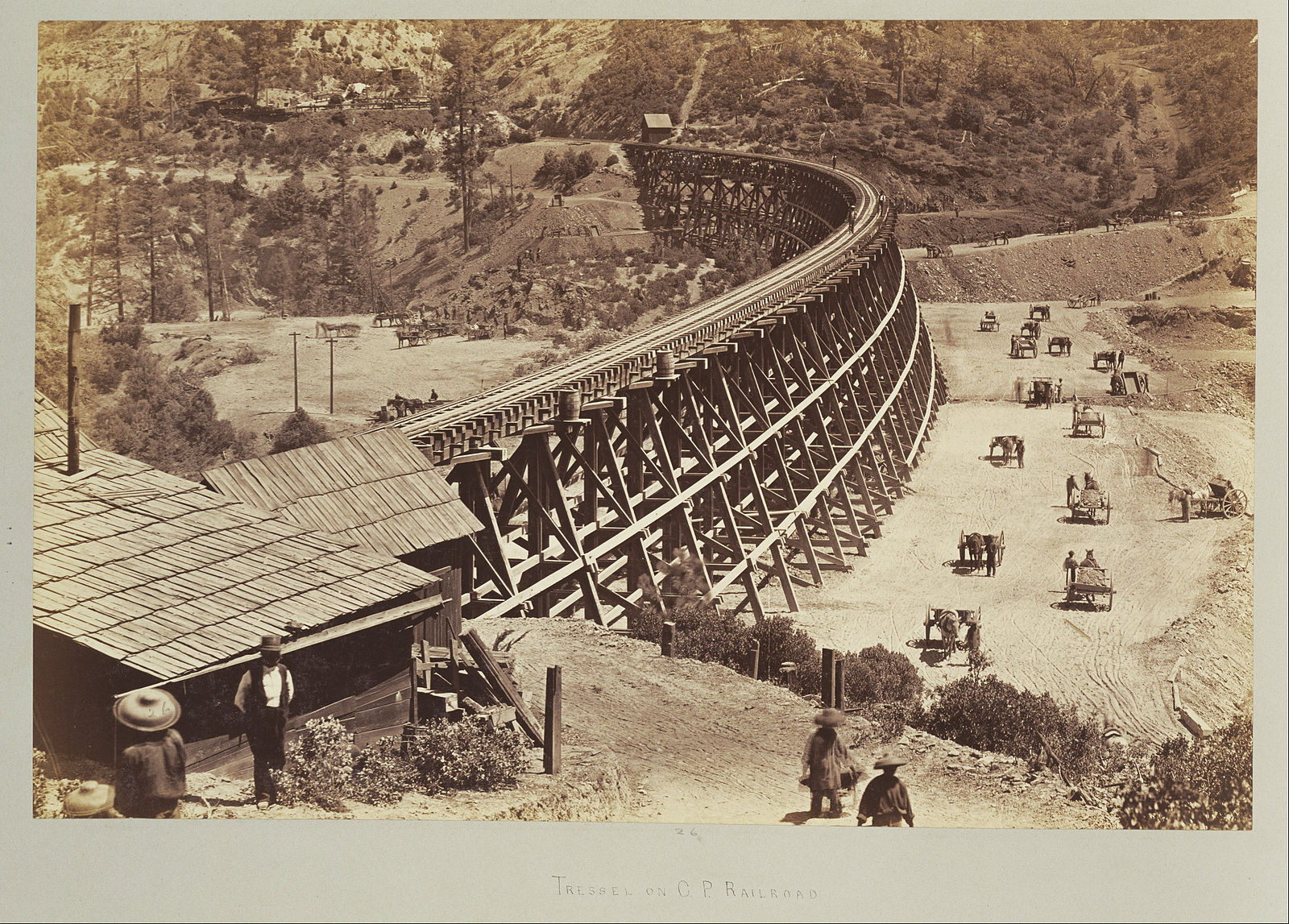6.6.1 - Chinese American Contributions to Business and Entrepreneurship
Lesson Plan to Support Committee of 100's
From Foundations to Frontiers: Chinese American Contributions to the Fabric of America Report
The Asian American Education Project
All content is owned by The Asian American Education Project (AAEdu).
As such, users agree to attribute all work to The Asian American Education Project.
Grade: 6-9Subject:
History, Social Science, English Language Arts
Number of Lessons/Activities: 4 + Extension Activities
San Francisco’s Chinatown is bustling with Chinese American businesses and entrepreneurs.
Chinese Americans have contributed to the U.S. economy in many ways.
Credit: Kārlis Dambrāns from Latvia, CC BY 2.0
https://creativecommons.org/licenses/by/2.0, via Wikimedia Commons
Source
This lesson plan supports the Committee of 100’s report entitled, "
From Foundations to Frontiers: Chinese American Contributions to the Fabric of America.” It specifically addresses the section entitled, “Building an Economic Powerhouse” (pp. 17-28). More specifically, it focuses on the history of Chinese American contributions to the infrastructure of the country, including their contributions to business and entrepreneurship today.
In this lesson, students will learn about past and present Chinese American entrepreneurs who have transformed society through the creation of laundry industries, the construction of railroads that united the country, and the design of media platforms that are used by millions of people each day. Students will research Chinese American entrepreneurs and identify the various challenges they faced.
Students will:
- Describe the contributions of Chinese Americans to U.S. business and entrepreneurship
- Define “Bamboo Ceiling” and identify barriers faced by Chinese Americans in corporate leadership
Chinese American Contributions to Business and Entrepreneurship Essay:
The U.S.
economy is one of the strongest in the world. This is a result of the work of generations of immigrants. For example, Chinese Americans have made great contributions. Since immigrating in large numbers in the mid-1800s, they have increased the U.S. economy in many ways.
Initially, they provided much-needed labor. The main reason for Chinese
migration to the United States was economic. Many Chinese immigrants arrived during the
Gold Rush (1848). They mined for gold. But, they faced much
discrimination. For instance, they were required to pay unfair taxes. They were driven out of towns. They were victims of violence.
As such, they found other ways to make a
profit. They formed small businesses. At first, they served Chinese
consumers. But later, they started businesses to provide essential services to everyone. Early Chinese immigrants worked in laundries. During the Gold Rush, few women were available to do laundry. And, White men didn't want to do such work. So, laundry was shipped to Hong Kong and later, Hawai'i, to be cleaned. This was very expensive. Chinese immigrants saw an opportunity. They provided local and cheaper services. Chinese
entrepreneurs established the first
commercial laundry business in the American West. In 1851, Wah Lee opened the first known Chinese laundry in San Francisco. By 1870, there were over 1,300 Chinese laundries in San Francisco. Chinese businesses made up the majority of laundries in the city.
Chinese Americans were among the first immigrants to play a major role in building the country’s
infrastructure. For example, they helped build the railroads. These railroads connected the country, from east to west. From 1865 to 1869, more than 20,000 Chinese workers were employed by the Central Pacific Railroad (CPRR). They made up over 90% of the workforce. Building the western half of the project, Chinese workers had the most dangerous jobs. These jobs included
blacksmithing,
carpentry,
tunneling,
leveling of
roadbeds, and laying tracks.
From 1860-1910, Chinese Americans also transformed
agricultural development in California. They had experience developing fertile farmland. They knew how to control waterways. They transformed dry river valleys. They were hired to reclaim lands in the Sacramento-San Joaquin Delta.
Since the mid-1900s, Chinese Americans have entered
occupations across every industry. These
industries included science,
high-technology, food service, medicine, education, and more. Many are founders and leaders of large companies like Yahoo, YouTube, Zoom, and DoorDash.
Many Chinese Americans hold professional jobs. Yet, they are underrepresented in leadership roles. This is especially true in
Corporate America. In 2018, Chinese Americans accounted for about 3% of professional occupations. But, they held only 1.5% of mid-level management roles. They held only 1.2% of executive positions. In comparison, White workers held about 69% of professional occupations. But, about 74% of mid-level managers and 85% of executives are White.
Chinese Americans, as well as other people of color, are kept out of corporate leadership positions. This is called a
"bamboo ceiling." This concept was
coined by Jane Hyun in 2005. It refers to barriers faced by Asian Americans in the workplace. Some barriers include stereotyping and racism. These barriers have led to a lack of advancement and leadership opportunities.
Today, there are over 160,000 Chinese American-owned businesses in the United States. Chinese Americans have made significant economic contributions. They are consumers, employees, business owners, and corporate leaders. They have contributed to the country’s
Gross Domestic Product (GDP). This is a measure of the value of all goods and services produced in a country. Chinese Americans have also created many jobs. In addition, they have increased
capital growth market, which is the value of money invested over time.
*This text is an excerpt from the Committee of 100’s report entitled, “From Foundations to Frontiers: Chinese American Contributions to the Fabric of America.” It has been adapted for reading accessibility and clarity.
- Agriculture: the process of cultivating soil and growing crops
- "Bamboo ceiling": a term created in 2005 by Jane Hyun in “Breaking the Bamboo Ceiling: Career Strategies for Asians” that explains barriers faced by Asian Americans in the workplace such as stereotyping and racism which creates a lack of advancement and leadership opportunities
- Blacksmithing: the making and repairing of things in iron by hand
- Capital market growth: an increase in the value of something over time
- Carpentry: the making or repairing of things in wood
- Coined: invented a new word or phrase
- Commercial: relating to commerce, the buying and selling of goods and services on a large scale
- Consumers: people who buy things
- Corporate: businesses that operate for profit, or to make money
- Corporate America: a phrase to describe the world of big business in the United States
- Discrimination: unjust treatment based on differences, especially categories such as ethnicity, age, sex, or disability
- Economy: the production, distribution, and consumption of goods and services
- Entrepreneur: someone who organizes, manages, and takes on the risks of a business in order to eventually make a profit
- Industry: a specific area of activity or interest, like a job category
- Infrastructure: the foundation or basic framework of a country (includes roads, bridges, buildings, railroads, etc.)
- Gross Domestic Product (GDP): a number that measures the value of all goods and services produced in a country
- Gold Rush: a rapid movement of people to a newly discovered gold field; the first major gold rush was to California in 1848–49
- High-technology: scientific technology involving the production or use of advanced or sophisticated devices especially in the fields of electronics and computers
- Leveling: the act of making flat or evening out
- Migration: movement of people from one area to another
- Occupations: jobs
- Profit: earned money
- Roadbeds: the part of the surface of a road traveled by vehicles
- Tunneling: the digging or forcing of passages underground or through something like mountains
- Why did early Chinese immigrants come to the United States?
- How were early Chinese immigrants discriminated against?
- Why were early Chinese immigrants forced to create their own businesses? How did they overcome the discrimination?
- How did Chinese immigrants demonstrate an entrepreneurial spirit? How did they fill a need or a gap?
In Activity 1, students use the internet to find visual representations of businesses or industries that were created or impacted by Chinese Americans.
Credit: “Iphone, Laptop, Macbook pro” by Pexels via
Pixabay. (Free for use under the Pixabay Content License)
Source
Activity 1: Visualizing Chinese American Contributions (Suggested Time: 20 minutes)
- Have students work in small groups to find one internet image of each of the following concepts: laundromat, railroad, agriculture, Yahoo logo, and YouTube logo.
- Have students add images to a slide deck for easy reference.
- Have students include a caption for each image defining each concept. Review the definitions.
- Facilitate a discussion by asking the following questions:
- Have you used any of the following items or services in these images? When? How?
- What do these items or services have in common?
- Tell students: “All of the images represent something that was created by or impacted by Chinese Americans. All of the images represent businesses (like YouTube) or important American industries (like agriculture).”
- Have students list other contributions made by Chinese Americans. Record student responses and display for all to see. Facilitate a discussion by asking the following questions:
- How do you know these contributions were made by Chinese Americans?
- Why don’t we know more about Chinese American contributions?
- Tell students that they will be learning about the contributions of Chinese Americans throughout history and in the present day.

Activity 2: Building an Economic Powerhouse (Suggested time: 60 minutes)
- Have students read the essay. Consider the following options:
- OPTION 1: Have students read the essay independently either for homework or during class time.
- OPTION 2: Read aloud the essay and model annotating.
- OPTION 3: Have students read aloud in pairs or small groups.
- Facilitate a class discussion by asking the following questions:
- Why did early Chinese immigrants come to the United States?
- How were early Chinese immigrants discriminated against?
- Why were early Chinese immigrants forced to create their own businesses? How did they overcome the discrimination?
- How did Chinese immigrants demonstrate an entrepreneurial spirit? How did they fill a need or a gap?
- Distribute the worksheet entitled, “Contributions of Chinese.” Have students (either independently or working in small groups) complete the worksheet using information from the text. Facilitate a discussion by asking the following questions:
- In what ways did Chinese Americans contribute to the building of the United States as an economic power?
- How did Chinese Americans shape and change various American industries?
- Tell students that a high Gross Domestic Product indicates a strong economic country. Have students complete this chart as an entire class:
|
|
What are these roles? What do they do? |
How do they impact the strength of a country? |
|
Consumers |
|
|
|
Employees |
|
|
|
Business Owners |
|
|
|
Corporate Leaders |
|
|
- Have students identify the paragraphs that discuss the “bamboo ceiling.” Re-read these paragraphs. Have students summarize the gist or main idea of the paragraph. Facilitate a discussion by asking the following questions:
- What is the “bamboo ceiling”? Why is it called that?
- How does the “bamboo ceiling” impact Chinese Americans?
- Why is it important to see Asian Americans in leadership roles?
- Why might Asian Pacific Islander Desi Americans be seen more as labor and not as leaders?
- Have students make a list of their role models. Facilitate a discussion by asking the following questions:
- Why are these folks your role model?
- What does it mean to have a role model who looks like you and/or comes from a similar background?
- Why is it problematic to not see people who look like you in positions of power?
- Why does representation matter?

Activity 3: Biographies of Chinese Americans (Suggested time per Option: 60 minutes)
Teachers can have students complete one or more of the following options:
- OPTION 1: Have students research and write a LinkedIn bio or a resume about a Chinese American who has contributed to business and/or entrepreneurship. These profiles should include educational background, work experiences, skills/talents, significant contributions/achievements, and more. Some examples include: Chien-Shiung Wu, Tung-Yen Lin, I.M. Pei, Jerry Yang, Steve Chen, Eric Yuan, Alfred Lin, Aileen Lee, Yiqing “Pocket” Sun, Vera Wang, etc. Have students share their findings by presenting their profiles or via a Gallery Walk.
- OPTION 2: Have students research a Chinese American who has contributed to business and/or entrepreneurship. Have them identify the person’s significant contribution, what problem they solved, and how they improved U.S. society. Then, have students assume the role of an entrepreneur and identify a problem they would like to solve by creating their own businesses. Have students brainstorm a good business idea, write and pitch a business proposal, draft budgets, create marketing materials, and more. Host a “Business Expo” where students can share their business ideas with others and pitch an idea to solve their stated problem.

This photograph shows a trestle on the Central Pacific Railroad in 1887. From 1865 to 1869, more than 20,000 Chinese workers were employed by the Central Pacific Railroad (CPRR).
They made up over 90% of the workforce.
Credit: Carleton Watkins, Getty Center, Public domain, via
Wikimedia Commons Source:
https://www.getty.edu/
Activity 4: Contributions and Obstacles of Chinese Americans (Suggested time: 60 minutes)
- Distribute the worksheet entitled, “CER Writing Strategy.” Review the concepts of claims, evidence and reasoning as needed.
- Have students write a paragraph response to one of these prompts:
- In what ways have Chinese Americans contributed to American business?
- What obstacles have Chinese Americans faced (or currently face) in business?
- Tell students to use examples from the essay or from their own research.
Extension Activities (Suggested time per Option: 30- 60 minutes)
- Have students learn more about the “bamboo ceiling” by reading this article entitled,
“What is the 'bamboo ceiling'? Here's what Asian Americans want you to know.” Have students identify the two main arguments in the article. Have students identify the claim, evidence, and reasoning for each argument. Facilitate a discussion by having students take a position.
- Have students research the “glass ceiling.” Have them complete a Venn Diagram and compare and contrast the glass ceiling and the bamboo ceiling. Facilitate a discussion by having students analyze who has power and who doesn’t and why.
- Have students examine the charts, graphs, and data in the
C100 report about Chinese American contributions to business. Ask students to identify X and Y axes (when applicable), explain what the graph is depicting, and write claims that can be supported by each graph.
- See Figure 3, pg. 17: “The 20 occupations with the highest share of Chinese American workers, as of 2018 (among the top 100 US occupations).”
- See Figure 4, pg. 18: “The economic contributions of Chinese Americans.”
- See Figure 5, pg. 23: “Chinese American members of the NAE and NAS by election year, as of June 2020.”
- Have students interview a Chinese American business owner to learn more about his/her/their successes and struggles. Have students create a poster about their subject and share via a digital Gallery Walk.
- Coordinate a field trip to a local Chinese American business and/or have a local Chinese American business owner speak to the class. Have students identify three things they learned, two things they want to know more about, and one thing that inspired them. Have students write thank-you notes to the Chinese American business owner.
Additional Fictional Resources
- Front Desk by Kelly Yang (Scholastic Press, 2019) - Have students discuss what it means for Mia’s family to run a business and what the motel symbolizes for them. Have students evaluate the arrangement between Mr. Yao and Mia’s parents for owning and running the motel. Have students brainstorm ways their arrangement could be more fair.
- It’s Boba Time for Pearl Li! by Nicole Chen (Quill Tree Books, 2023) - Have students complete a T-Chart of the challenges and successes Pearl and Auntie Cha face as they navigate their businesses. Have students discuss what it means to be an entrepreneur and to start your own business. Have students brainstorm creative solutions to help a small business in need. Have students work in teams to write a small business proposal.
- Made in Korea by Sarah Suk (Simon & Schuster Books for Young Readers, 2022) - Have students examine how the main characters demonstrate entrepreneurial skills. Have students analyze the business side of Korean pop culture and its influence in the United States and globally.






